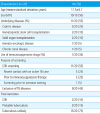Abstract
Purpose
There is a the great diagnostic challenge in pediatric tuberculosis especially in high burden setting. The purpose of this preliminary study is to evaluate the agreement between tuberculin skin test (TST) and interferon-gamma release assay (IGRA) including T-SPOT®.TB and QuantiFERON®-TB Gold (QFT-G) in Korean children.
Method
This retrospective study included children and adolescents who visited to Asan Medical Center to evaluate tuberculosis infection using at least two assays of TST, T-SPOT.TB and QFT-G, from January 2014 to April 2015.
Results
A total of 20 patients were included, whose median age was 13.3 years (range, 3.8–18.1 years), and all of them had history of BCG vaccination. Eleven patients had underlying diseases including 7 patients with immunosuppressant medication. The concordance rate between T-SPOT.TB and QFT-G was 90%. However, the concordance rate between TST and T-SPOT.TB was 50%, and between TST and QFT-G was 42.9%. Specificity for the diagnosis of tuberculosis infection of T-SPOT.TB, QFT-G, and TST was 93.3%, 86.7%, and 58.3%, respectively.
Conclusions
Although there was a discrepancy between TST and IGRA to diagnose tuberculosis, agreement between T-SPOT.TB and QFT-G was relatively high. Further prospective study to validate the clinical usefulness of each assay for immunologic evidence of tuberculosis infection in Korean children will be mandatory.
Figures and Tables
References
1. Nelson LJ, Wells CD. Global epidemiology of childhood tuberculosis. Int J Tuberc Lung Dis. 2004; 8:636–647.
2. Korea Centers for Disease Control and Prevention. Assessed 6 October 2015. Available at: http://cdc.go.kr/CDC/health/CdcKrHealth0101.jsp?menuIds=HOME001-MNU1132-MNU1147-MNU0746-MNU0747&fid=751&cid=14191.
3. Horsburgh CR Jr. Priorities for the treatment of latent tuberculosis infection in the United States. N Engl J Med. 2004; 350:2060–2067.

4. Joint Committee for the Development of Korean Guidelines for Tuberculosis. Korean guidelines for tuberculosis. 2nd ed. Seoul: Korea Centers for Disease Control and Prevention;2014. p. 158–167.
5. Lee HW, Park HY, Ahn YM, Sohn KC. Clinical significance of interferon-γ release assay for diagnosis of tuberculosis in children. Korean J Pediatr Infect Dis. 2010; 17:137–147.

6. Sung JY, Kim JH, Yang MA, Kim SH, Eun BW, Lee J, et al. Usefulness of interferon-γ measurement following stimulation of tuberculosis-specific antigens for diagnosis of latent tuberculosis infection in children exposed to pulmonary tuberculosis. Korean J Pediatr Infect Dis. 2008; 15:51–57.

7. Choi JW, Kim MS, Kim JH. Comparison of results between tuberculin skin test and QuantiFERON®-TB in-tube assay for diagnosis of latent tuberculosis infection in children and adolescents. Korean J Pediatr Infect Dis. 2013; 20:17–27.

8. Ferrara G, Losi M, D'Amico R, Roversi P, Piro R, Meacci M, et al. Use in routine clinical practice of two commercial blood tests for diagnosis of infection with Mycobacterium tuberculosis: a prospective study. Lancet. 2006; 367:1328–1334.

9. Graham SM, Ahmed T, Amanullah F, Browning R, Cardenas V, Casenghi M, et al. Evaluation of tuberculosis diagnostics in children: 1. Proposed clinical case definitions for classification of intrathoracic tuberculosis disease. Consensus from an expert panel. J Infect Dis. 2012; 205:S199–S208.

10. Spicer KB, Turner J, Wang SH, Koranyi K, Powell DA. Tuberculin skin testing and T-SPOT.TB in internationally adopted children. Pediatr Infect Dis J. 2015; 34:599–603.

11. Lee YJ, Chun P, We JH, Park SE. Accuracy of an interferon-gamma release assay to detect active tuberculosis in children: a pilot study. Korean J Pediatr Infect Dis. 2011; 18:48–53.

12. Machingaidze S, Wiysonge CS, Gonzalez-Angulo Y, Hatherill M, Moyo S, Hanekom W, et al. The utility of an interferon gamma release assay for diagnosis of latent tuberculosis infection and disease in children: a systematic review and meta-analysis. Pediatr Infect Dis J. 2011; 30:694–700.





 PDF
PDF ePub
ePub Citation
Citation Print
Print






 XML Download
XML Download